12 product adoption metrics to track for success
.png)
.png)
.png)
.png)
Product adoption isn't just about user growth—it’s the key to long-term retention and sustainable revenue. In this guide, you’ll learn how to measure adoption with 12 essential metrics, uncover where users get stuck, and drive continuous improvement using a proven four-part framework.
How do you measure success in product adoption? In some ways, it’s not too unlike the game Battleship.
In case we’re dating ourselves, let’s recap what Battleship is. In the game, success is all about probing away at your opponents board, recording your hits and misses along the way. Each red and white peg whittles down your opponent's hiding spots until you’re crowned the victor.
To achieve success for SaaS products, PMs need to use a similar approach—trying new things, measuring with product adoption metrics, and finding a winning strategy that’ll leave their competitors capsized.
Like Battleship, educated trial and error is the only way to find success in product adoption. Use these 12 product adoption metrics as true-north markers—that way, for every test shot you fire, you have a way of marking whether it was a hit or miss.
Measuring product adoption helps you understand how effectively users are embracing your product—and where they’re dropping off. By tracking adoption metrics, you can pinpoint what’s working, identify friction points, and improve the user journey to increase retention and revenue.
Product adoption occurs when users choose your product as their go-to solution. But adoption doesn’t happen by accident—it’s a process that unfolds in stages. Monitoring how users progress through these stages allows you to optimize onboarding, feature discovery, and long-term engagement.
In short, product adoption metrics turn user behavior into actionable insights—helping you build better experiences, reduce churn, and grow sustainably.
To improve product adoption, you’ll need to measure it over time by identifying the metrics that make the most sense for your product. Here are 12 metrics you should start with to get a real feel for how your product is doing.
Your conversion rate measures how many people “look at your product” versus “begin using your product.” Your “total visitors” will vary based on how you define a conversion: it could be everyone who signs up for a free trial, clicks on an ad, or becomes a paying customer.
For example, if your free trial conversion rate is low, that means users don’t see the value or it’s taking too long to show them that value.
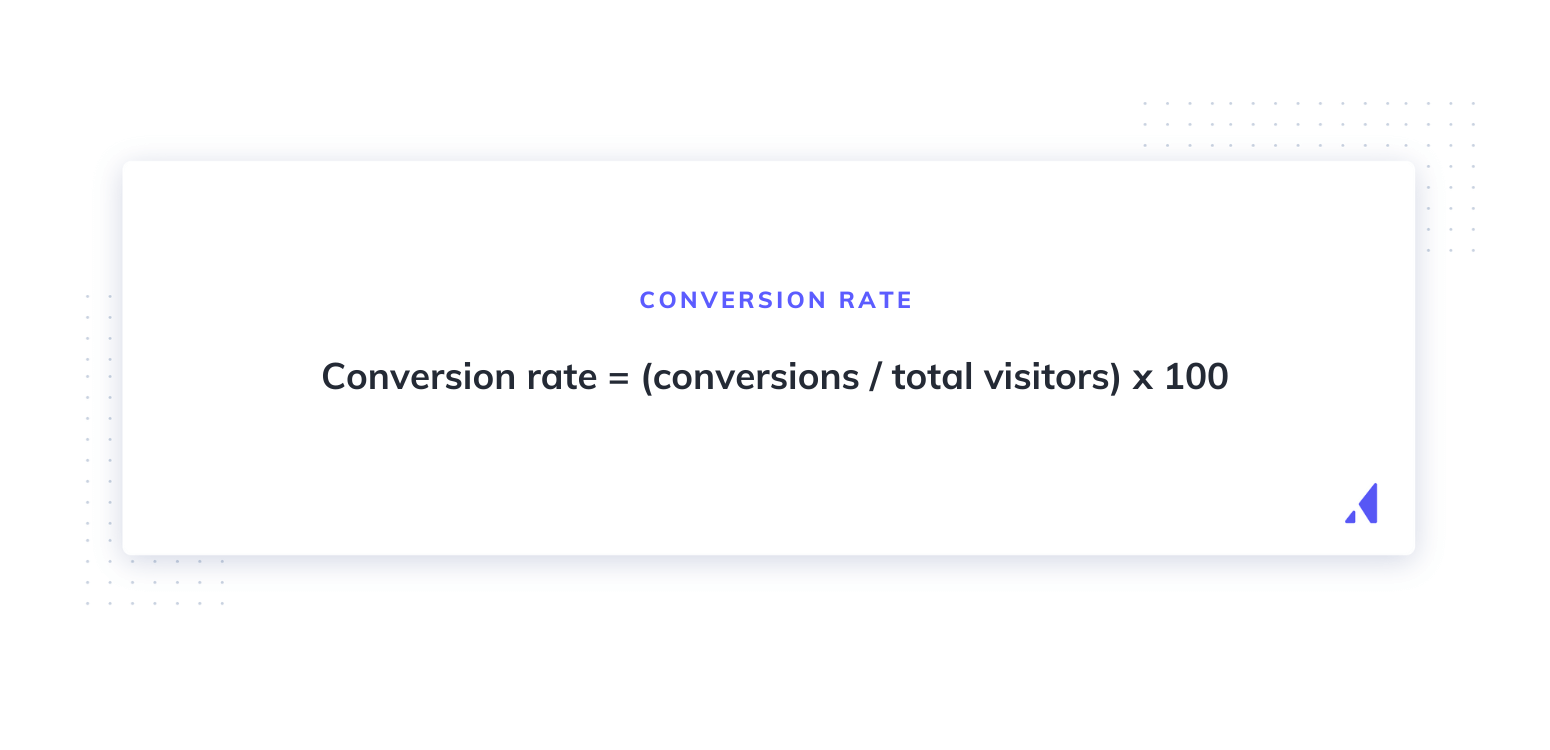
Adoption rate is measured by the number of customers using a feature. Specifically, you’re looking at the total number of users for that feature as a percentage of the total number of users for your product as a whole.
This metric helps you identify features that suffer from adoption friction. Maybe users weren’t aware of that feature or it took too long for them to adopt that feature, and they gave up. In any case, the product adoption rate will show you the breadth of adoption for that feature so that you can take steps to shore up poorly performing features.
Time to value is the amount of time it takes for a user to experience the core value of your product after signing up. It measures the period between initial user interaction and the moment they reach their aha moment—when the product’s value becomes clear.
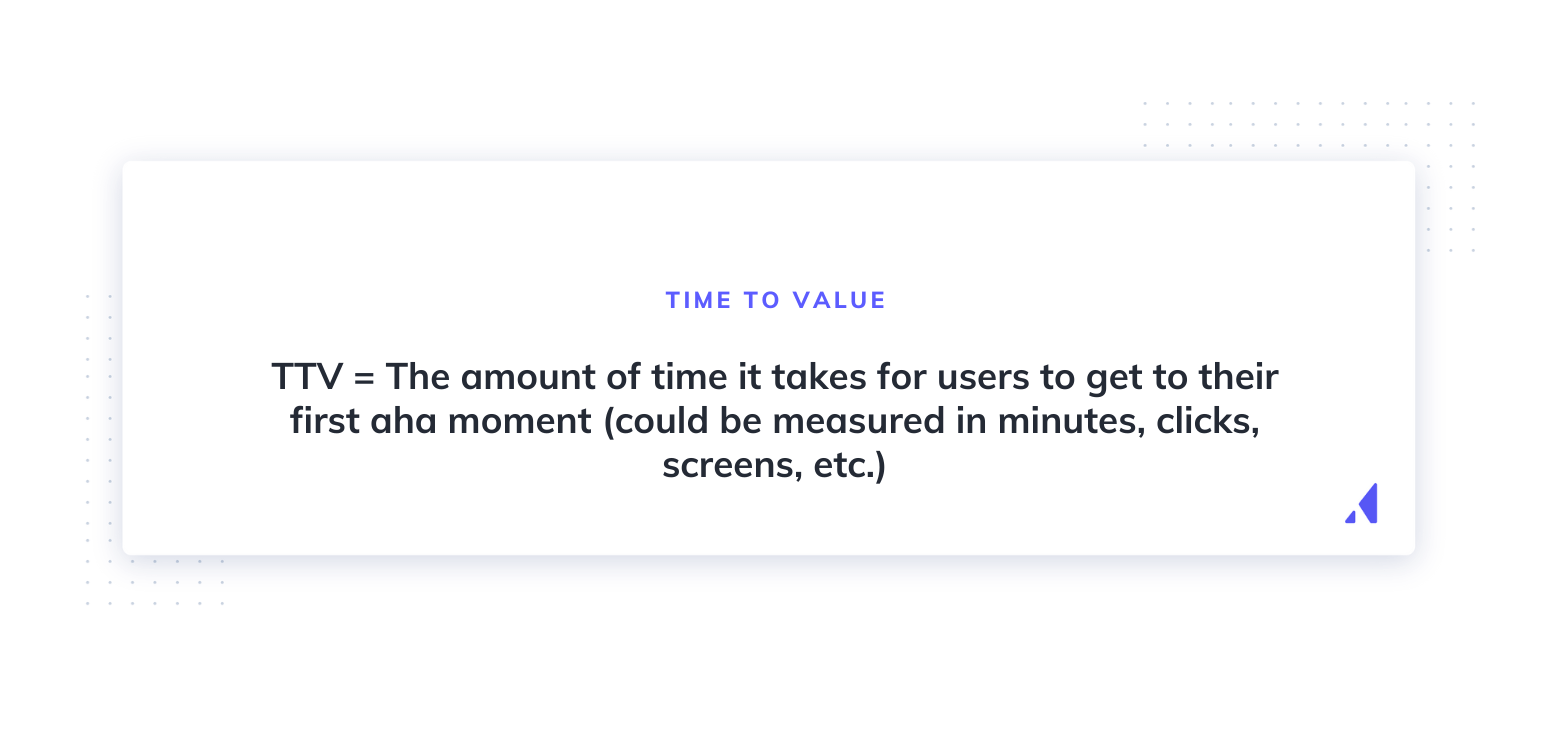
How you define that tipping point will depend on your product. It could be using your product 3 times or setting up a customer profile. Search through your product usage metrics, figure out a leading activation indicator, and use that to start measuring time to value.
Activation rate measures the percentage of users who complete a key action that signals they've experienced initial value—often called the “aha” moment.
Just as you need to measure the time to value, you should also measure how successful you are at getting them to achieve your activation event. Making your time to value only 30 seconds is fantastic, but if you’re only getting 40% of your users to complete your activation event, you still have a lot of work to do.
If your activation rate is low, retool your onboarding flow to encourage users to activate. You need to motivate users by making your onboarding simple, displaying their progress, and rewarding their effort in any way you can. Do all this, and you’ll see activation rates heading in the right direction soon enough.
Usage frequency tracks how often users return to your product after completing their initial onboarding. It reflects ongoing engagement and helps you understand whether users continue to find value—even after reaching their initial “aha” moment. Usually, usage frequency is measured after your users complete their initial onboarding phase.
Look at your Daily Active Users (DAUs), Weekly Active Users (WAUs), or Monthly Active Users (MAUs) as a percentage of the total users to see your product’s usage frequency. By looking at usage frequency, you can identify users who may lack product knowledge and need additional support to stick around.
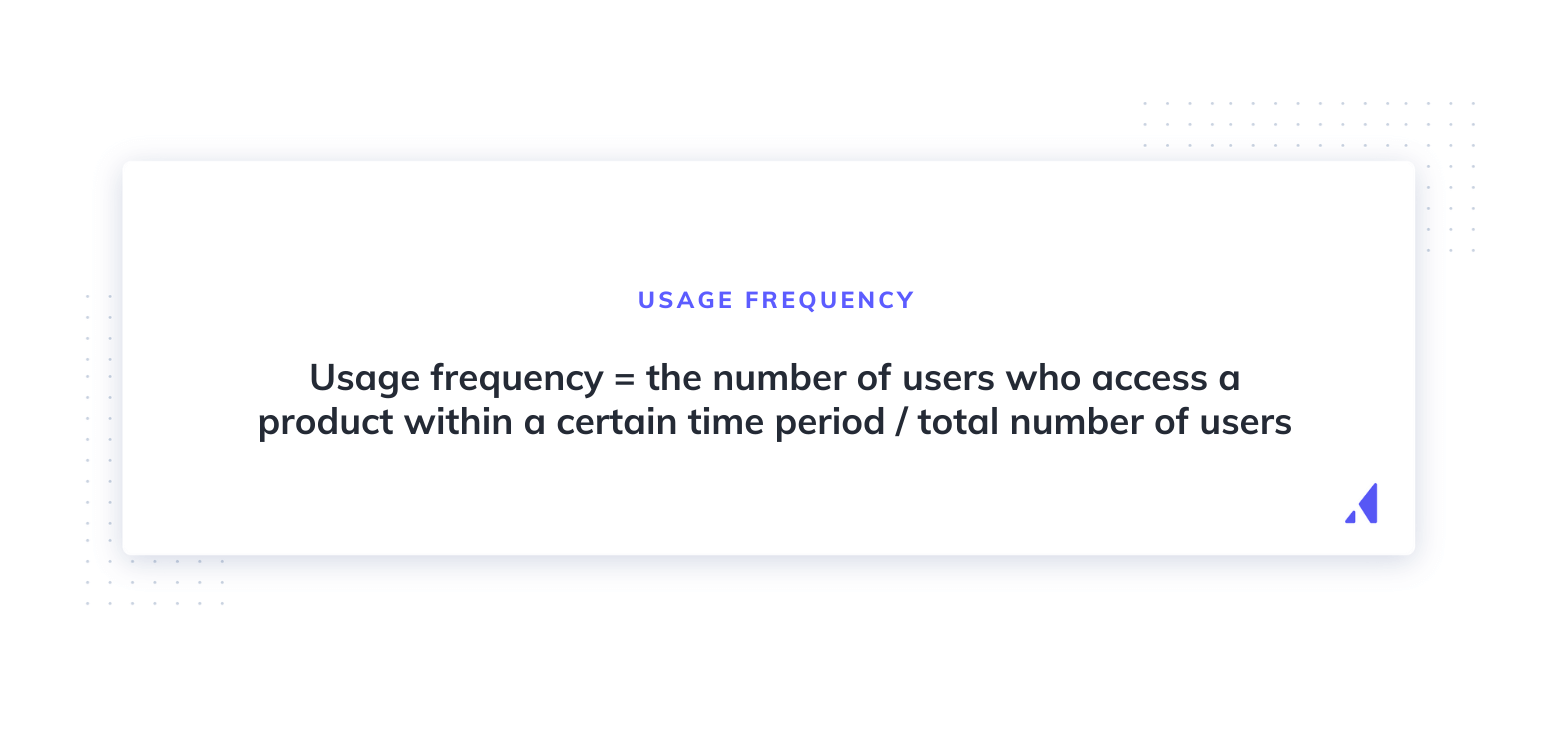
Churn rate measures the percentage of customers who stop using your product over a given time period. It helps you track user retention and identify how well you're maintaining long-term engagement and satisfaction.
Users leave products all the time. It's a natural part of the user life cycle—but that doesn't mean you shouldn’t be doing everything you can to slow or stop churn. Churn can be measured in a number of ways, and one of the best is simply to look at the percentage of customer churn. Essentially, this metric tells you what percentage of your customers are leaving compared to your total customer base.
Track your churn rates monthly to see how well your long-term user adoption strategies are working. If you’re chipping away at friction points and improving feature flows, you’ll see that churn line improve over time.
Customer Lifetime Value (CLTV) estimates the total revenue a business can expect from a single customer over the course of their relationship. It reflects long-term product adoption and is a key metric for assessing the overall health and profitability of your user base.
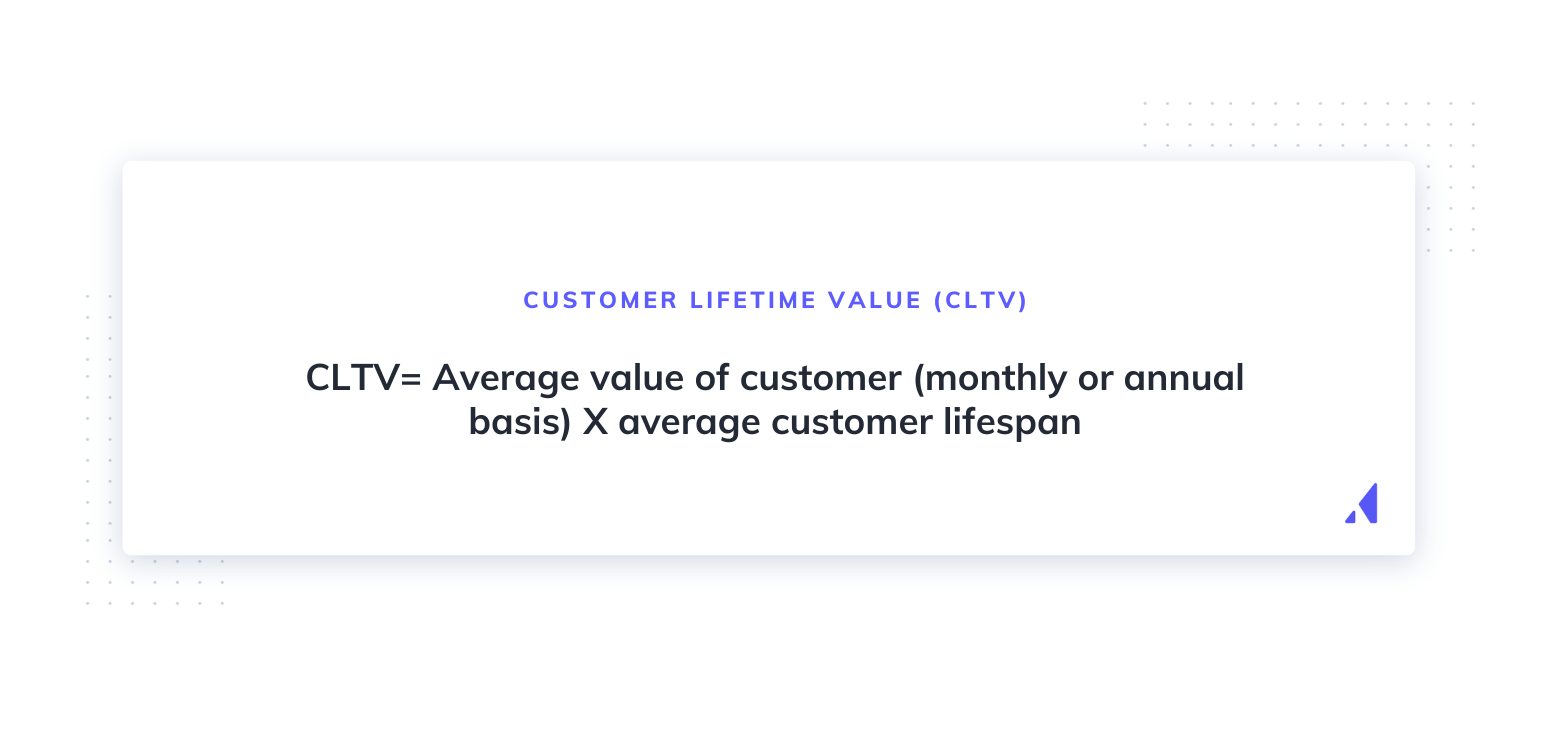
When user adoption metrics trend in the right direction for SaaS products, the average value of a customer over their lifetime goes up as they stick around longer. For that reason, tracking CLTV is a high-level way of making sure your product adoption game is still going strong.
CLTV is a broad metric that accounts for many factors, one of which is product adoption. PMs should not take this metric as gospel, as a high CLTV could hide other lingering issues in the funnel. However, CLTV is great for getting buy-in from other stakeholders as it demonstrates how user adoption tracking and optimizations benefit the bottom line.
Average session duration measures how long users stay active in your product during a single session. It helps you gauge user engagement and whether your product experience encourages deeper or more sustained use over time.
Many SaaS products are built on attention. The more they can keep users logged in and using their product, the better they’re doing their jobs. Average session duration measures how well your product engages users and encourages them to come back for longer and longer sessions.
Consider the goal of your product when evaluating average session duration. If you’re trying to save users’ time, a longer session duration might not be a positive indicator. Instead, set a target session duration and use that to measure success.
Upsell rate measures the percentage of users who upgrade to a higher-tier plan or purchase additional features. It indicates how well your product drives continued value and deeper adoption among existing users.

People don’t upgrade or upsell if they’re not hooked on what you have to offer. For this reason, your upsell rate indicates how well you’ve gotten those users to buy into your product and its vision.
The best way to use your upsell rate metric is to look at it by user segment. With that data, it becomes clear which user groups are adopting your product the most. Study what’s working with these groups to improve upsell metrics or change things up for lower-performing segments to get them caught up.
Net Promoter Score (NPS) measures how likely users are to recommend your product to others. It reflects customer loyalty and is a strong indicator of whether users have fully adopted and embraced your product.
Regular people don’t recommend products they’re just lukewarm about. If you’re going to recommend a friend or colleague use something, it’s probably a tool you’re 100% sold on as the best solution for that problem. In other words, that person has completely adopted that product and is now urging others to adopt it too.
NPS scores are one way to measure how well your product is getting people to this level of product adoption. The best part is that NPS is usually measured right after the user finishes using your product. This means their opinion is fresh and gives you a real insight into how good your most important or new features really are.
Customer Satisfaction (CSAT) measures how satisfied users are with your product, typically through short surveys scored on a scale (e.g., 1 to 5). It captures user sentiment and helps assess whether the experience meets expectations after key interactions.
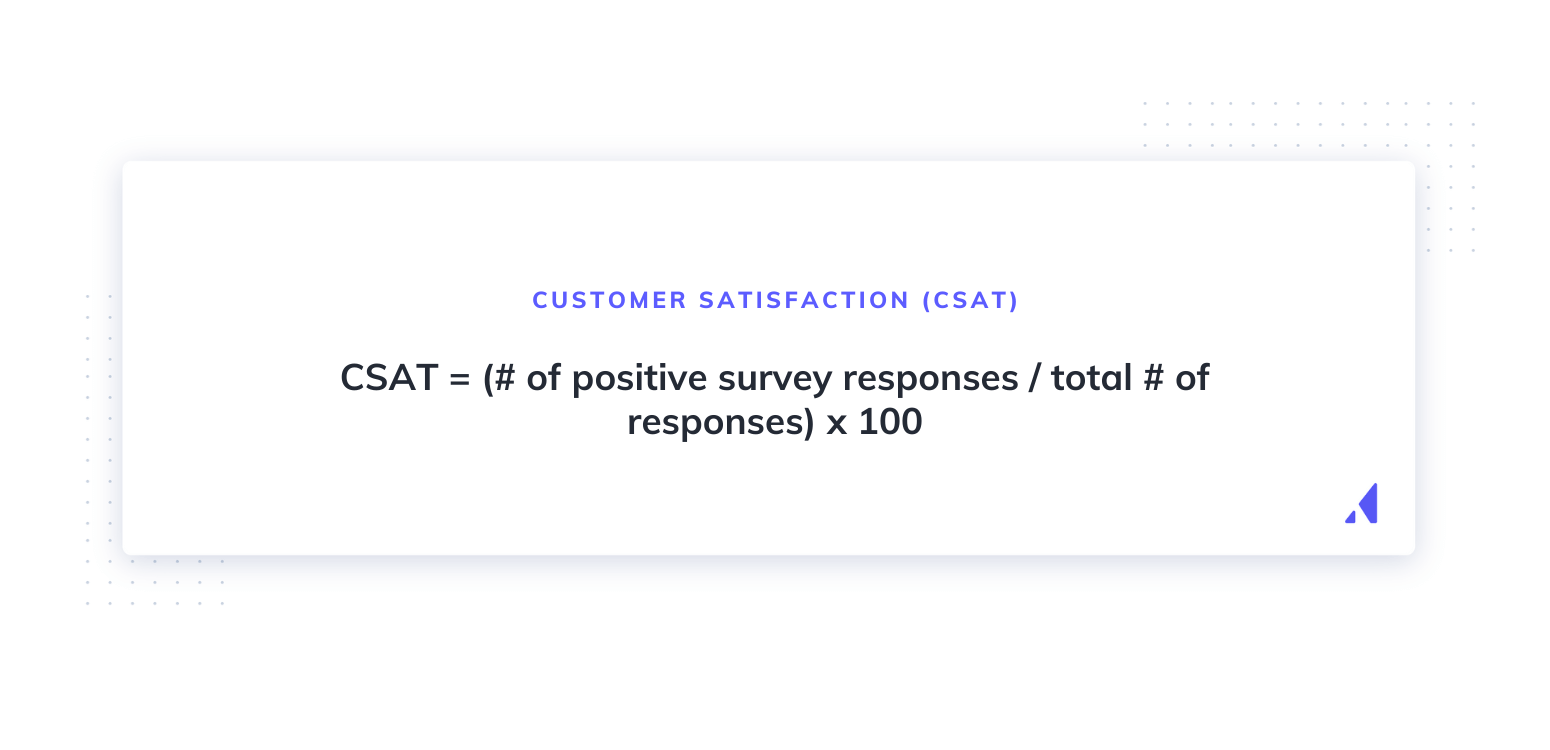
CSAT surveys are short questionnaires that measure user sentiment on a scale of 1 to 5. The scores are then collected to see how satisfied your customers are with your product—this makes it ideal for taking the pulse of users after they’ve finished your onboarding process or other important flows.
Other adoption metrics on this list measure product usage but fail to understand sentiment. Do users actually like your product? Did they enjoy using it? CSAT gives you that info so you can work on mapping out a more user-friendly product with a better overall experience.
The best product adoption metrics are the ones that help you understand four key things:
Every product is different, so your adoption metrics should be tailored to reflect your unique customer journey and business goals. By aligning your metrics with this four-part framework—breadth, depth, timing, and duration of adoption—you’ll gain clearer insights into user behavior and where to optimize.
The sections below break down each of these dimensions and suggest the most relevant metrics for tracking them. Once you identify the right fit, you'll be better equipped to guide more users to their “aha moment”—and keep them coming back.
Breadth of adoption refers to how widely your product has been adopted across your customer base. If people aren’t using the product regularly or not using it as expected, they likely won’t benefit from it and will be more likely to churn. Not great.
So, determine the ideal usage frequency for your product; i.e., how often do people need to use it within a time frame for the product to be valuable? Then look at your total user base and break down the number of users who are DAUs, WAUs, or MAUs. Note how many users meet your ideal frequency and how many don’t fall into any category. People in the latter group probably haven’t reached their “aha moment” yet.
Some metrics you could track to understand the breadth of adoption:
Strong product adoption often results from helpful features users can’t live without. We recommended figuring out which features are driving adoption—as well as which aren't—by identifying those with the most traction.
While a good percentage of your users may be DAUs, some users within that group might not use a key feature. Also, if users only touch one feature (out of many), that may indicate a weak depth of adoption.
Weak product adoption depth causes issues with a feature’s relevance, difficulty in use, or lack of overall user engagement.
Some metrics you could track to understand the depth of adoption:
Timing is everything when it comes to product adoption. Users who fail to see value quickly may switch to another product.
This can also hold true when you roll out a new feature and users take too long to adopt it because they miss an opportunity to see additional value from your product. It can also indicate user frustration if they “can’t figure something out” (which could be due to UI/UX issues).
Some metrics you could track to understand time to adopt:
You may discover that users adopt a product quickly (an amazing onboarding experience can help!) but then lose interest over time. Duration shows if users continue to see value beyond the initial novelty.
When the duration of product adoption is low, it may mean that your product needs a refresh or that users prefer emerging competitor products. Either way, if the duration of adoption is low and you cannot increase it, users will likely churn over time.
Some metrics you could track to understand the duration of adoption:
To measure product adoption, track key user actions and engagement over time using product analytics tools. The goal is to understand how users interact with your product—especially during onboarding, feature discovery, and long-term usage.
Here’s how to set up a reliable measurement plan:
Determine the specific user actions that align with each metric. For example:
Use a product analytics platform (like Amplitude, Mixpanel, or Heap) to track behavior inside your product. You can also incorporate:
Choose a reporting frequency that matches the natural pace of change for each metric:
Tip: Some metrics (like TTV) need longer timelines to show meaningful movement—don’t over-report them too early.
Once you’ve collected your data:
The goal is to turn behavior into insight—and insight into action. With the right tracking setup and cadence, your adoption metrics will become a roadmap for driving user success and business growth.
You’re tracking product adoption metrics and have results to analyze—great! Now what? Ask yourself, “How can I help users better understand or use this product?” Here are several winning tactics you can try to increase overall product adoption.
Not all users will discover the value of your product on their own. A great onboarding can hold the hands of those users to show them exactly what they’d be missing if they choose to walk away from your product.
If your metrics show that users aren’t activating or even completing onboarding, you need to revamp your onboarding to reduce time to value and improve overall customer satisfaction. That way, customers won’t get stuck in onboarding and churn before you’ve even had a chance to win them over.
Common elements of a great user onboarding experience include:
Check out these 10 great user onboarding examples (they’re amazing—seriously).
Users may not even realize new features are available. Don’t expect users to read your product release notes and learn about new features on their own. Instead, use in-app messaging and announcements to alert users about new features.
Feature announcements can direct users to other resources, such as videos or blog posts, which explain the feature in more detail. Teach users about the value of these new features, and they'll be more likely to embrace them in the product.
Check out our guide to improving feature adoption through in-app messaging.
What about those “infrequent” users who don’t open your app often enough to be aware of new features or other changes? Email is an easy way to stay connected with these users and improve their product adoption.
You can also use emails to remind users of your product's value, offer tips and tricks, and make users aware of new product features. These messages can help improve usage frequency by encouraging people to return to your product.
Your product launch strategy should feature not just one but a series of emails to build momentum around new features to get users committing to your product from Day 1.
Going over product adoption metrics in isolation won't turn your product into an overnight success. You also need to understand how to use what you learn from those metrics to create product-led growth.
Product-led growth is a method of producing sustainable SaaS growth by using the product to generate new and continuous use. As you find and fix problems in your product, you create a better UX that encourages users to use and share your product with other people. As you get the product-led flywheel moving, more users lead to more referrals, and voila—sustainable growth.
If you want to start harnessing the power of product-led growth, check out our Product Adoption Academy where you can take free courses in creating product experiences that’ll knock your users’ socks off.
Measuring product adoption helps you understand how users engage with your product across four dimensions: who is adopting, what features they use, when they reach value, and how long they stick around. The 12 metrics covered in this guide—like conversion rate, time to value, feature adoption, churn, and NPS—give you a full picture of user behavior and product performance. By tracking these metrics regularly, using the right tools, and sharing insights across teams, you can identify friction points, optimize onboarding, boost engagement, and drive product-led growth.